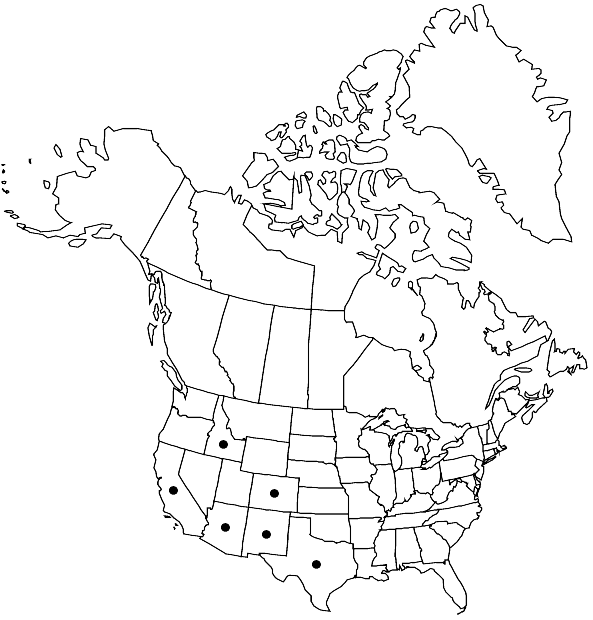Difference between revisions of "Syntrichia bartramii"
Bull. Buffalo Soc. Nat. Sci. 32: 267. 1993,.
FNA>Volume Importer |
FNA>Volume Importer |
||
| Line 24: | Line 24: | ||
|elevation=moderate to high elevations | |elevation=moderate to high elevations | ||
|distribution=Ariz.;Calif.;Colo.;Idaho;N.Mex.;Tex.;Mexico (Baja California). | |distribution=Ariz.;Calif.;Colo.;Idaho;N.Mex.;Tex.;Mexico (Baja California). | ||
| − | |discussion=<p>Diagnostic features of the rare Syntrichia bartramii include plane leaf margins and the costa excurrent into a tapered, serrate awn. In contrast with those of S. fragilis, the leaves of S. bartramii are not fragile and have awns, somewhat smaller, more obscure distal cells, less well-defined groups of basal cells, and plane margins. Without propagula, plants of S. laevipila can be separated from S. bartramii by the abaxially smooth costae and smooth awns, and also by larger and less obscure leaf cells. It should be noted that leaves of S. bartramii sometimes show 2-stratose patches (one or a few cells in width). In contrast, S. chisosa has leaves that are almost completely 2-stratose distally, less twisted when dry, and merely mucronate at the apex.</p> | + | |discussion=<p>Diagnostic features of the rare <i>Syntrichia bartramii</i> include plane leaf margins and the costa excurrent into a tapered, serrate awn. In contrast with those of <i>S. fragilis</i>, the leaves of <i>S. bartramii</i> are not fragile and have awns, somewhat smaller, more obscure distal cells, less well-defined groups of basal cells, and plane margins. Without propagula, plants of <i>S. laevipila</i> can be separated from <i>S. bartramii</i> by the abaxially smooth costae and smooth awns, and also by larger and less obscure leaf cells. It should be noted that leaves of <i>S. bartramii</i> sometimes show 2-stratose patches (one or a few cells in width). In contrast, <i>S. chisosa</i> has leaves that are almost completely 2-stratose distally, less twisted when dry, and merely mucronate at the apex.</p> |
|tables= | |tables= | ||
|references= | |references= | ||
| Line 47: | Line 47: | ||
|publication year= | |publication year= | ||
|special status= | |special status= | ||
| − | |source xml=https://jpend@bitbucket.org/aafc-mbb/fna-data-curation.git/src/ | + | |source xml=https://jpend@bitbucket.org/aafc-mbb/fna-data-curation.git/src/8f726806613d60c220dc4493de13607dd3150896/coarse_grained_fna_xml/V27/V27_907.xml |
|subfamily=Pottiaceae subfam. Pottioideae | |subfamily=Pottiaceae subfam. Pottioideae | ||
|genus=Syntrichia | |genus=Syntrichia | ||
Revision as of 17:58, 18 September 2019
Stems 2–10 mm. Leaves infolded and spirally twisted around the stem when dry, wide-spreading when moist, lingulate to spatulate, 1.25–2 × 0.5–0.75 mm; margins plane, entire, except for papillose crenulations, not bordered; apices acute to truncate or occasionally emarginate; costa excurrent into a conspicuously tapered, serrate awn 0.1–0.6 mm, red or yellow, sparsely to densely spinulose abaxially; basal cells abruptly differentiated, with somewhat thickened cross walls, those at the margins narrower; distal cells irregularly polygonal, isodiametric, 9–13 µm, obscure, bulging and densely papillose, with 4–6 papillae per cell, moderately thick-walled and not collenchymatous. Specialized asexual reproduction absent. Sexual condition dioicous (perigonia and sporophytes unknown).
Habitat: Dry soil and rocks
Elevation: moderate to high elevations
Distribution

Ariz., Calif., Colo., Idaho, N.Mex., Tex., Mexico (Baja California).
Discussion
Diagnostic features of the rare Syntrichia bartramii include plane leaf margins and the costa excurrent into a tapered, serrate awn. In contrast with those of S. fragilis, the leaves of S. bartramii are not fragile and have awns, somewhat smaller, more obscure distal cells, less well-defined groups of basal cells, and plane margins. Without propagula, plants of S. laevipila can be separated from S. bartramii by the abaxially smooth costae and smooth awns, and also by larger and less obscure leaf cells. It should be noted that leaves of S. bartramii sometimes show 2-stratose patches (one or a few cells in width). In contrast, S. chisosa has leaves that are almost completely 2-stratose distally, less twisted when dry, and merely mucronate at the apex.
Selected References
None.